Review of Energy Communities: Definitions, Regulations, Topologies, and Technologies
Abstract
Highlights
- Overview of energy communities: definition and characterization.
- Analysis of technologies and typologies for energy communities.
- Condensed survey of regulations for energy communities.
- Investigation of centralized and decentralized systems for energy communities.
Abstract
1. Introduction
2. Regulations in ECs
3. Technologies and System Architectures
3.1. Energy Storage Systems
3.2. Demand Management
3.3. Internet of Things
3.4. Blockchain
3.5. Digital Technologies
3.6. Energy Management Systems
3.7. Smart Grids
4. Conclusions
Author Contributions
Funding
Acknowledgments
Conflicts of Interest
References
- Angelis-Dimakis, A.; Biberacher, M.; Dominguez, J.; Fiorese, G.; Gadocha, S.; Gnansounou, E.; Guariso, G.; Kartalidis, A.; Panichelli, L.; Pinedo, I.; et al. Methods and Tools to Evaluate the Availability of Renewable Energy Sources. Renew. Sustain. Energy Rev. 2011, 15, 1182–1200. [Google Scholar] [CrossRef]
- The European Green Deal. Available online: https://commission.europa.eu/strategy-and-policy/priorities-2019-2024/european-green-deal_en (accessed on 9 October 2024).
- Hossain, M.S.; Madlool, N.A.; Rahim, N.A.; Selvaraj, J.; Pandey, A.K.; Khan, A.F. Role of Smart Grid in Renewable Energy: An Overview. Renew. Sustain. Energy Rev. 2016, 60, 1168–1184. [Google Scholar] [CrossRef]
- Frieden, D.; Tuerk, A.; Roberts, J.; D’Herbemont, S.; Gubina, A.F.; Komel, B. Overview of Emerging Regulatory Frameworks on Collective Self-Consumption and Energy Communities in Europe. In Proceedings of the 2019 16th International Conference on the European Energy Market (EEM), Ljubljana, Slovenia, 18–20 September 2019; pp. 1–6. [Google Scholar] [CrossRef]
- Golla, A.; Röhrig, N.; Staudt, P.; Weinhardt, C. Evaluating the Impact of Regulation on the Path of Electrification in Citizen Energy Communities with Prosumer Investment. Appl. Energy 2022, 319, 119241. [Google Scholar] [CrossRef]
- Roberts, J. What Energy Communities Need from Regulation. Eur. Energy Clim. J. 2019, 8, 13–27. [Google Scholar] [CrossRef]
- Parra-Domínguez, J.; Sánchez, E.; Ordóñez, Á. The Prosumer: A Systematic Review of the New Paradigm in Energy and Sustainable Development. Sustainability 2023, 15, 10552. [Google Scholar] [CrossRef]
- IEA Expects 320 GW Global RE Capacity in 2022. Available online: https://taiyangnews.info/business/iea-expects-320-gw-global-re-capacity-in-2022 (accessed on 9 October 2024).
- Popescu, M.O.; Popescu, C.L.; Sima, C.A. Electric Power’s Seasons. In Proceedings of the 2019 11th International Symposium on Advanced Topics in Electrical Engineering (ATEE), Bucharest, Romania, 28–30 March 2019; pp. 1–4. [Google Scholar] [CrossRef]
- Sørensen, B. A History of Renewable Energy Technology. Energy Policy 1991, 19, 8–12. [Google Scholar] [CrossRef]
- Popescu, M.O.; Popescu, C.L. Renewable Energy Sources: Principles and Applications; Electrca: Bucharest, Romania, 2010; pp. 54–96. [Google Scholar]
- Ritzer, G.; Dean, P.; Jurgenson, N. The Coming of Age of the Prosumer. Am. Behav. Sci. 2012, 56, 379–398. [Google Scholar] [CrossRef]
- Zafar, R.; Mahmood, A.; Razzaq, S.; Ali, W.; Naeem, U.; Shehzad, K. Prosumer Based Energy Management and Sharing in Smart Grid. Renew. Sustain. Energy Rev. 2018, 82, 1675–1684. [Google Scholar] [CrossRef]
- Brown, D.; Hall, S.; Davis, M.E. Prosumers in the Post Subsidy Era: An Exploration of New Prosumer Business Models in the UK. Energy Policy 2019, 135, 110984. [Google Scholar] [CrossRef]
- Energy Communities. Available online: https://energy.ec.europa.eu/topics/markets-and-consumers/energy-consumers-and-prosumers/energy-communities_en (accessed on 9 October 2024).
- Aruta, G.; Ascione, F.; Bianco, N.; Iovane, T.; Mastellone, M.; Maria Mauro, G. Optimizing the Energy Transition of Social Housing to Renewable Nearly Zero-Energy Community: The Goal of Sustainability. Energy Build. 2023, 282, 112798. [Google Scholar] [CrossRef]
- Otamendi-Irizar, I.; Grijalba, O.; Arias, A.; Pennese, C.; Hernández, R. How Can Local Energy Communities Promote Sustainable Development in European Cities? Energy Res. Soc. Sci. 2022, 84, 102363. [Google Scholar] [CrossRef]
- Trapani, D.; Marocco, P.; Ferrero, D.; Lindberg, K.B.; Sundseth, K.; Santarelli, M. The Potential of Hydrogen-Battery Storage Systems for a Sustainable Renewable-Based Electrification of Remote Islands in Norway. J. Energy Storage 2024, 75, 109482. [Google Scholar] [CrossRef]
- Johannsen, R.M.; Sorknæs, P.; Sperling, K.; Østergaard, P.A. Energy Communities’ Flexibility in Different Tax and Tariff Structures. Energy Convers. Manag. 2023, 288, 117112. [Google Scholar] [CrossRef]
- De São José, D.; Faria, P.; Vale, Z. Smart Energy Community: A Systematic Review with Metanalysis. Energy Strategy Rev. 2021, 36, 100678. [Google Scholar] [CrossRef]
- Bielig, M.; Kacperski, C.; Kutzner, F.; Klingert, S. Evidence behind the Narrative: Critically Reviewing the Social Impact of Energy Communities in Europe. Energy Res. Soc. Sci. 2022, 94, 102859. [Google Scholar] [CrossRef]
- Hamwi, M.; Lizarralde, I. A Review of Business Models towards Service-Oriented Electricity Systems. Procedia CIRP 2017, 64, 109–114. [Google Scholar] [CrossRef]
- Pons-Seres De Brauwer, C.; Cohen, J.J. Analysing the Potential of Citizen-Financed Community Renewable Energy to Drive Europe’s Low-Carbon Energy Transition. Renew. Sustain. Energy Rev. 2020, 133, 110300. [Google Scholar] [CrossRef]
- Reis, I.F.G.; Gonçalves, I.; Lopes, M.A.R.; Henggeler Antunes, C. Business Models for Energy Communities: A Review of Key Issues and Trends. Renew. Sustain. Energy Rev. 2021, 144, 111013. [Google Scholar] [CrossRef]
- Eisner, A.; Neumann, C.; Manner, H. Exploring Sharing Coefficients in Energy Communities: A Simulation-Based Study. Energy Build. 2023, 297, 113447. [Google Scholar] [CrossRef]
- Li, N.; Hakvoort, R.A.; Lukszo, Z. Cost Allocation in Integrated Community Energy Systems—Performance Assessment. Appl. Energy 2022, 307, 118155. [Google Scholar] [CrossRef]
- Viti, S.; Lanzini, A.; Minuto, F.D.; Caldera, M.; Borchiellini, R. Techno-Economic Comparison of Buildings Acting as Single-Self Consumers or as Energy Community through Multiple Economic Scenarios. Sustain. Cities Soc. 2020, 61, 102342. [Google Scholar] [CrossRef]
- Fina, B. Energy Community Incurred Grid Cost Redistribution Mechanisms Considering Different Objectives and Aspects of Fairness. Energy Rep. 2024, 11, 6238–6254. [Google Scholar] [CrossRef]
- Gasca, M.-V.; Rigo-Mariani, R.; Debusschere, V.; Sidqi, Y. Fairness in Energy Communities: Centralized and Decentralized Frameworks. Renew. Sustain. Energy Rev. 2025, 208, 115054. [Google Scholar] [CrossRef]
- Berg, K.; Foslie, S.S.; Farahmand, H. Industrial Energy Communities: Energy Storage Investment, Grid Impact and Cost Distribution. Appl. Energy 2024, 373, 123908. [Google Scholar] [CrossRef]
- Doukas, H.; Marinakis, V. Energy Poverty Alleviation: Effective Policies, Best Practices and Innovative Schemes. Energy Sources Part B Econ. Plan. Policy 2020, 15, 45–48. [Google Scholar] [CrossRef]
- Lowitzsch, J.; Hoicka, C.E.; Van Tulder, F.J. Renewable Energy Communities under the 2019 European Clean Energy Package—Governance Model for the Energy Clusters of the Future? Renew. Sustain. Energy Rev. 2020, 122, 109489. [Google Scholar] [CrossRef]
- Cielo, A.; Margiaria, P.; Lazzeroni, P.; Mariuzzo, I.; Repetto, M. Renewable Energy Communities Business Models under the 2020 Italian Regulation. J. Clean. Prod. 2021, 316, 128217. [Google Scholar] [CrossRef]
- Inês, C.; Guilherme, P.L.; Esther, M.-G.; Swantje, G.; Stephen, H.; Lars, H. Regulatory Challenges and Opportunities for Collective Renewable Energy Prosumers in the EU. Energy Policy 2020, 138, 111212. [Google Scholar] [CrossRef]
- Adly, B.; El-Khouly, T. Combining Retrofitting Techniques, Renewable Energy Resources and Regulations for Residential Buildings to Achieve Energy Efficiency in Gated Communities. Ain Shams Eng. J. 2022, 13, 101772. [Google Scholar] [CrossRef]
- Iwaro, J.; Mwasha, A. A Review of Building Energy Regulation and Policy for Energy Conservation in Developing Countries. Energy Policy 2010, 38, 7744–7755. [Google Scholar] [CrossRef]
- European Commission. Available online: https://energy.ec.europa.eu/topics/energy-strategy/clean-energy-all-europeans-package_en (accessed on 9 October 2024).
- Directive (EU) 2018/2001. Available online: https://eur-lex.europa.eu/legal-content/EN/TXT/PDF/?uri=CELEX:32018L2001 (accessed on 9 October 2024).
- Directive (EU) 2019/944. Available online: https://eur-lex.europa.eu/legal-content/EN/TXT/PDF/?uri=CELEX:32019L0944 (accessed on 9 October 2024).
- Directive (EU) 2018/2022. Available online: https://energy.ec.europa.eu/topics/energy-efficiency/energy-efficiency-targets-directive-and-rules/energy-efficiency-directive_en (accessed on 9 October 2024).
- Regulation 2019/943. Available online: https://eur-lex.europa.eu/legal-content/EN/TXT/PDF/?uri=CELEX:32019R0943 (accessed on 9 October 2024).
- Regulation 2018/1999. Available online: https://eur-lex.europa.eu/legal-content/EN/TXT/PDF/?uri=CELEX:32018R1999 (accessed on 9 October 2024).
- Bartolini, A.; Carducci, F.; Muñoz, C.B.; Comodi, G. Energy Storage and Multi Energy Systems in Local Energy Communities with High Renewable Energy Penetration. Renew. Energy 2020, 159, 595–609. [Google Scholar] [CrossRef]
- Javadi, M.S.; Gough, M.; Nezhad, A.E.; Santos, S.F.; Shafie-khah, M.; Catalão, J.P.S. Pool Trading Model within a Local Energy Community Considering Flexible Loads, Photovoltaic Generation and Energy Storage Systems. Sustain. Cities Soc. 2022, 79, 103747. [Google Scholar] [CrossRef]
- Palensky, P.; Dietrich, D. Demand Side Management: Demand Response, Intelligent Energy Systems, and Smart Loads. IEEE Trans. Ind. Inf. 2011, 7, 381–388. [Google Scholar] [CrossRef]
- Sangaré, M.; Bourreau, E.; Fortz, B.; Pachurka, A.; Poss, M. Loads Scheduling for Demand Response in Energy Communities. Comput. Oper. Res. 2023, 160, 106358. [Google Scholar] [CrossRef]
- Faria, P.; Barreto, R.; Vale, Z. Demand Response in Energy Communities Considering the Share of Photovoltaic Generation from Public Buildings. In Proceedings of the 2019 International Conference on Smart Energy Systems and Technologies (SEST), Porto, Portugal, 9–11 September 2019; pp. 1–6. [Google Scholar] [CrossRef]
- Nykyri, M.; Karkkainen, T.J.; Annala, S.; Silventoinen, P. Review of Demand Response and Energy Communities in Serious Games. IEEE Access 2022, 10, 91018–91026. [Google Scholar] [CrossRef]
- Cutore, E.; Volpe, R.; Sgroi, R.; Fichera, A. Energy Management and Sustainability Assessment of Renewable Energy Communities: The Italian Context. Energy Convers. Manag. 2023, 278, 116713. [Google Scholar] [CrossRef]
- Oprea, S.-V.; Bâra, A. Edge and Fog Computing Using IoT for Direct Load Optimization and Control with Flexibility Services for Citizen Energy Communities. Knowl.-Based Syst. 2021, 228, 107293. [Google Scholar] [CrossRef]
- Adu-Kankam, K.O.; Camarinha-Matos, L.M. A Framework for the Integration of IoT Components into the Household Digital Twins for Energy Communities. In Internet of Things. IoT Through a Multi-Disciplinary Perspective; Camarinha-Matos, L.M., Ribeiro, L., Strous, L., Eds.; IFIP Advances in Information and Communication Technology; Springer International Publishing: Cham, Switzerland, 2022; Volume 665, pp. 197–216. [Google Scholar] [CrossRef]
- Wu, Y.; Wu, Y.; Cimen, H.; Vasquez, J.C.; Guerrero, J.M. Towards Collective Energy Community: Potential Roles of Microgrid and Blockchain to Go beyond P2P Energy Trading. Appl. Energy 2022, 314, 119003. [Google Scholar] [CrossRef]
- Kounelis, I.; Giuliani, R.; Geneiatakis, D.; Di Gioia, R.; Karopoulos, G.; Steri, G.; Neisse, R.; Nai Fovino, I. Blockchain in Energy Communities, A Proof of Concept, EUR 29074 EN; Publications Office of the European Union: Luxembourg, 2017; JRC110298. [Google Scholar] [CrossRef]
- Mengelkamp, E.; Gärttner, J.; Rock, K.; Kessler, S.; Orsini, L.; Weinhardt, C. Designing Microgrid Energy Markets. Appl. Energy 2018, 210, 870–880. [Google Scholar] [CrossRef]
- Adu-Kankam, K.O.; Camarinha-Matos, L.M. Collaborative Digital Twins: The Case of the Energy Communities. SN Comput. Sci. 2023, 4, 664. [Google Scholar] [CrossRef]
- Coignard, J.; Janvier, M.; Debusschere, V.; Moreau, G.; Chollet, S.; Caire, R. Evaluating Forecasting Methods in the Context of Local Energy Communities. Int. J. Electr. Power Energy Syst. 2021, 131, 106956. [Google Scholar] [CrossRef]
- Matos, M.; Almeida, J.; Gonçalves, P.; Baldo, F.; Braz, F.J.; Bartolomeu, P.C. A Machine Learning-Based Electricity Consumption Forecast and Management System for Renewable Energy Communities. Energies 2024, 17, 630. [Google Scholar] [CrossRef]
- Li, S.; Wang, J.; Zhang, H.; Liang, Y. Solar Photovoltaic Power Forecasting System with Online Manner Based on Adaptive Mode Decomposition and Multi-Objective Optimization. Comput. Electr. Eng. 2024, 118, 109407. [Google Scholar] [CrossRef]
- Karova, R. Regional Electricity Markets in Europe: Focus on the Energy Community. Util. Policy 2011, 19, 80–86. [Google Scholar] [CrossRef]
- Nykyri, M.; Kärkkäinen, T.J.; Levikari, S.; Honkapuro, S.; Annala, S.; Silventoinen, P. Blockchain-Based Balance Settlement Ledger for Energy Communities in Open Electricity Markets. Energy 2022, 253, 124180. [Google Scholar] [CrossRef]
- Backe, S.; Korpås, M.; Tomasgard, A. Heat and Electric Vehicle Flexibility in the European Power System: A Case Study of Norwegian Energy Communities. Int. J. Electr. Power Energy Syst. 2021, 125, 106479. [Google Scholar] [CrossRef]
- Srithapon, C.; Månsson, D. Predictive Control and Coordination for Energy Community Flexibility with Electric Vehicles, Heat Pumps and Thermal Energy Storage. Appl. Energy 2023, 347, 121500. [Google Scholar] [CrossRef]
- Ornetzeder, M.; Rohracher, H. Of Solar Collectors, Wind Power, and Car Sharing: Comparing and Understanding Successful Cases of Grassroots Innovations. Glob. Environ. Chang. 2013, 23, 856–867. [Google Scholar] [CrossRef]
- Barone, G.; Buonomano, A.; Forzano, C.; Palombo, A.; Russo, G. The Role of Energy Communities in Electricity Grid Balancing: A Flexible Tool for Smart Grid Power Distribution Optimization. Renew. Sustain. Energy Rev. 2023, 187, 113742. [Google Scholar] [CrossRef]
- Foroozandeh, Z.; Limmer, S.; Lezama, F.; Faia, R.; Ramos, S.; Soares, J. A MBNLP Method for Centralized Energy Pricing and Scheduling in Local Energy Community. In Proceedings of the 2022 IEEE PES Generation, Transmission and Distribution Conference and Exposition—Latin America (IEEE PES GTD Latin America), La Paz, Bolivia, 20–22 October 2022; pp. 1–6. [Google Scholar] [CrossRef]
- Fachrizal, R.; Munkhammar, J. Improved Photovoltaic Self-Consumption in Residential Buildings with Distributed and Centralized Smart Charging of Electric Vehicles. Energies 2020, 13, 1153. [Google Scholar] [CrossRef]
- Goli, P.; Jasthi, K.; Gampa, S.R.; Das, D.; Shireen, W.; Siano, P.; Guerrero, J.M. Electric Vehicle Charging Load Allocation at Residential Locations Utilizing the Energy Savings Gained by Optimal Network Reconductoring. Smart Cities 2022, 5, 177–205. [Google Scholar] [CrossRef]
- Feng, C.; Wen, F.; You, S.; Li, Z.; Shahnia, F.; Shahidehpour, M. Coalitional Game-Based Transactive Energy Management in Local Energy Communities. IEEE Trans. Power Syst. 2020, 35, 1729–1740. [Google Scholar] [CrossRef]
- Mamounakis, I.; Efthymiopoulos, N.; Makris, P.; Vergados, D.J.; Tsaousoglou, G.; Varvarigos, E. A Novel Pricing Scheme for Managing Virtual Energy Communities and Promoting Behavioral Change towards Energy Efficiency. Electr. Power Syst. Res. 2019, 167, 130–137. [Google Scholar] [CrossRef]
- Afzali, P.; Rashidinejad, M.; Abdollahi, A.; Salehizadeh, M.R.; Farahmand, H. A Stochastic Multi-objective Model for Energy Efficiency and Renewable Resource Planning in Energy Communities: A Sustainably Cost-effective Trade-off. IET Renew. Power Gen. 2023, 17, 1078–1091. [Google Scholar] [CrossRef]
- Krarti, M.; Aldubyan, M. Role of Energy Efficiency and Distributed Renewable Energy in Designing Carbon Neutral Residential Buildings and Communities: Case Study of Saudi Arabia. Energy Build. 2021, 250, 111309. [Google Scholar] [CrossRef]
- Wu, Y.; Wu, Y.; Guerrero, J.M.; Vasquez, J.C. Decentralized Transactive Energy Community in Edge Grid with Positive Buildings and Interactive Electric Vehicles. Int. J. Electr. Power Energy Syst. 2022, 135, 107510. [Google Scholar] [CrossRef]
- Mureddu, M.; Galici, M.; Ghiani, E.; Pilo, F. A Decentralized Market Solver for Local Energy Communities. In Proceedings of the 2020 55th International Universities Power Engineering Conference (UPEC), Torino, Italy, 1–4 September 2020; pp. 1–6. [Google Scholar] [CrossRef]
- Thapar, S. Centralized vs. Decentralized Solar: A Comparison Study (India). Renew. Energy 2022, 194, 687–704. [Google Scholar] [CrossRef]
- Li, L. Optimal Coordination Strategies for Load Service Entity and Community Energy Systems Based on Centralized and Decentralized Approaches. Energies 2020, 13, 3202. [Google Scholar] [CrossRef]
- Sima, C.A.; Popescu, C.L.; Popescu, M.O.; Roscia, M.; Seritan, G.; Panait, C. Techno-Economic Assessment of University Energy Communities with on/off Microgrid. Renew. Energy 2022, 193, 538–553. [Google Scholar] [CrossRef]
- Stennikov, V.; Barakhtenko, E.; Mayorov, G.; Sokolov, D.; Zhou, B. Coordinated Management of Centralized and Distributed Generation in an Integrated Energy System Using a Multi-Agent Approach. Appl. Energy 2022, 309, 118487. [Google Scholar] [CrossRef]
- Moroni, S. Energy Communities, Distributed Generation, Renewable Sources: Close Relatives or Potential Friends? Energy Res. Soc. Sci. 2024, 118, 103828. [Google Scholar] [CrossRef]
- Hatziargyriou, N. Differences and Synergies between Local Energy Communities and Microgrids. Oxf. Open Energy 2023, 2, oiac013. [Google Scholar] [CrossRef]
- Warneryd, M.; Karltorp, K. Microgrid Communities: Disclosing the Path to Future System-Active Communities. Sustain. Futur. 2022, 4, 100079. [Google Scholar] [CrossRef]
- Liu, C.; Li, Z. Comparison of Centralized and Peer-to-Peer Decentralized Market Designs for Community Markets. IEEE Trans. Ind. Appl. 2022, 58, 67–77. [Google Scholar] [CrossRef]
- Reddy, G.P.; Kumar, Y.V.P.; Chakravarthi, M.K. Communication Technologies for Interoperable Smart Microgrids in Urban Energy Community: A Broad Review of the State of the Art, Challenges, and Research Perspectives. Sensors 2022, 22, 5881. [Google Scholar] [CrossRef]
- Romero-Rubio, C.; De Andrés Díaz, J.R. Sustainable Energy Communities: A Study Contrasting Spain and Germany. Energy Policy 2015, 85, 397–409. [Google Scholar] [CrossRef]
- Oteman, M.; Wiering, M.; Helderman, J.-K. The Institutional Space of Community Initiatives for Renewable Energy: A Comparative Case Study of the Netherlands, Germany and Denmark. Energy Sustain. Soc. 2014, 4, 11. [Google Scholar] [CrossRef]
- Van Summeren, L.F.M.; Wieczorek, A.J.; Bombaerts, G.J.T.; Verbong, G.P.J. Community Energy Meets Smart Grids: Reviewing Goals, Structure, and Roles in Virtual Power Plants in Ireland, Belgium and the Netherlands. Energy Res. Soc. Sci. 2020, 63, 101415. [Google Scholar] [CrossRef]
- Oyewunmi, O.A.; Pantaleo, A.M.; Markides, C.N. ORC Cogeneration Systems in Waste-Heat Recovery Applications. Energy Procedia 2017, 142, 1736–1742. [Google Scholar] [CrossRef]
- Qiu, K.; Entchev, E. Biomass-Fired Organic Rankine Cycle-Based CHP for Community-Scale Applications. Energy Proc. 2022, 25. [Google Scholar] [CrossRef]
- Yaïci, W.; Annuk, A.; Entchev, E.; Longo, M.; Kalder, J. Organic Rankine Cycle-Ground Source Heat Pump with Seasonal Energy Storage Based Micro-Cogeneration System in Cold Climates: The Case for Canada. Energies 2021, 14, 5705. [Google Scholar] [CrossRef]
- Heidarnejad, P.; Genceli, H.; Hashemian, N.; Asker, M.; Al-Rawi, M. Biomass-Fueled Organic Rankine Cycles: State of the Art and Future Trends. Energies 2024, 17, 3788. [Google Scholar] [CrossRef]
- Hoffmann, E.; Mohaupt, F. Joint Storage: A Mixed-Method Analysis of Consumer Perspectives on Community Energy Storage in Germany. Energies 2020, 13, 3025. [Google Scholar] [CrossRef]
- Seyfang, G.; Hielscher, S.; Hargreaves, T.; Martiskainen, M.; Smith, A. A Grassroots Sustainable Energy Niche? Reflections on Community Energy in the UK. Environ. Innov. Soc. Transit. 2014, 13, 21–44. [Google Scholar] [CrossRef]
- Saunders, R.W.; Gross, R.J.K.; Wade, J. Can Premium Tariffs for Micro-Generation and Small Scale Renewable Heat Help the Fuel Poor, and If so, How? Case Studies of Innovative Finance for Community Energy Schemes in the UK. Energy Policy 2012, 42, 78–88. [Google Scholar] [CrossRef]
- Simcock, N. Procedural Justice and the Implementation of Community Wind Energy Projects: A Case Study from South Yorkshire, UK. Land Use Policy 2016, 59, 467–477. [Google Scholar] [CrossRef]
- Vernay, A.-L.; Sebi, C. Energy Communities and Their Ecosystems: A Comparison of France and the Netherlands. Technol. Forecast. Soc. Chang. 2020, 158, 120123. [Google Scholar] [CrossRef]
- Manso-Burgos, Á.; Ribó-Pérez, D.; Gómez-Navarro, T.; Alcázar-Ortega, M. Local Energy Communities Modelling and Optimisation Considering Storage, Demand Configuration and Sharing Strategies: A Case Study in Valencia (Spain). Energy Rep. 2022, 8, 10395–10408. [Google Scholar] [CrossRef]
- Parreño-Rodriguez, A.; Ramallo-González, A.P.; Chinchilla-Sánchez, M.; Molina-García, A. Community Energy Solutions for Addressing Energy Poverty: A Local Case Study in Spain. Energy Build. 2023, 296, 113418. [Google Scholar] [CrossRef]
- Pinto, E.S.; Serra, L.M.; Lázaro, A. Energy Communities Approach Applied to Optimize Polygeneration Systems in Residential Buildings: Case Study in Zaragoza, Spain. Sustain. Cities Soc. 2022, 82, 103885. [Google Scholar] [CrossRef]
- Dudka, A.; Moratal, N.; Bauwens, T. A Typology of Community-Based Energy Citizenship: An Analysis of the Ownership Structure and Institutional Logics of 164 Energy Communities in France. Energy Policy 2023, 178, 113588. [Google Scholar] [CrossRef]
- Salac, A.; Somera, J.; Castro, M.; Divinagracia-Luzadas, M.; Danao, L.; Ocon, J. Off-Grid Electrification Using Renewable Energy in the Philippines: A Comprehensive Review. Smart Cities 2024, 7, 1007–1043. [Google Scholar] [CrossRef]
- Walnum, H.T.; Hauge, Å.L.; Lindberg, K.B.; Mysen, M.; Nielsen, B.F.; Sørnes, K. Developing a Scenario Calculator for Smart Energy Communities in Norway: Identifying Gaps between Vision and Practice. Sustain. Cities Soc. 2019, 46, 101418. [Google Scholar] [CrossRef]
- Berg, K.; Löschenbrand, M. A Data Set of a Norwegian Energy Community. Data Brief 2022, 40, 107683. [Google Scholar] [CrossRef]

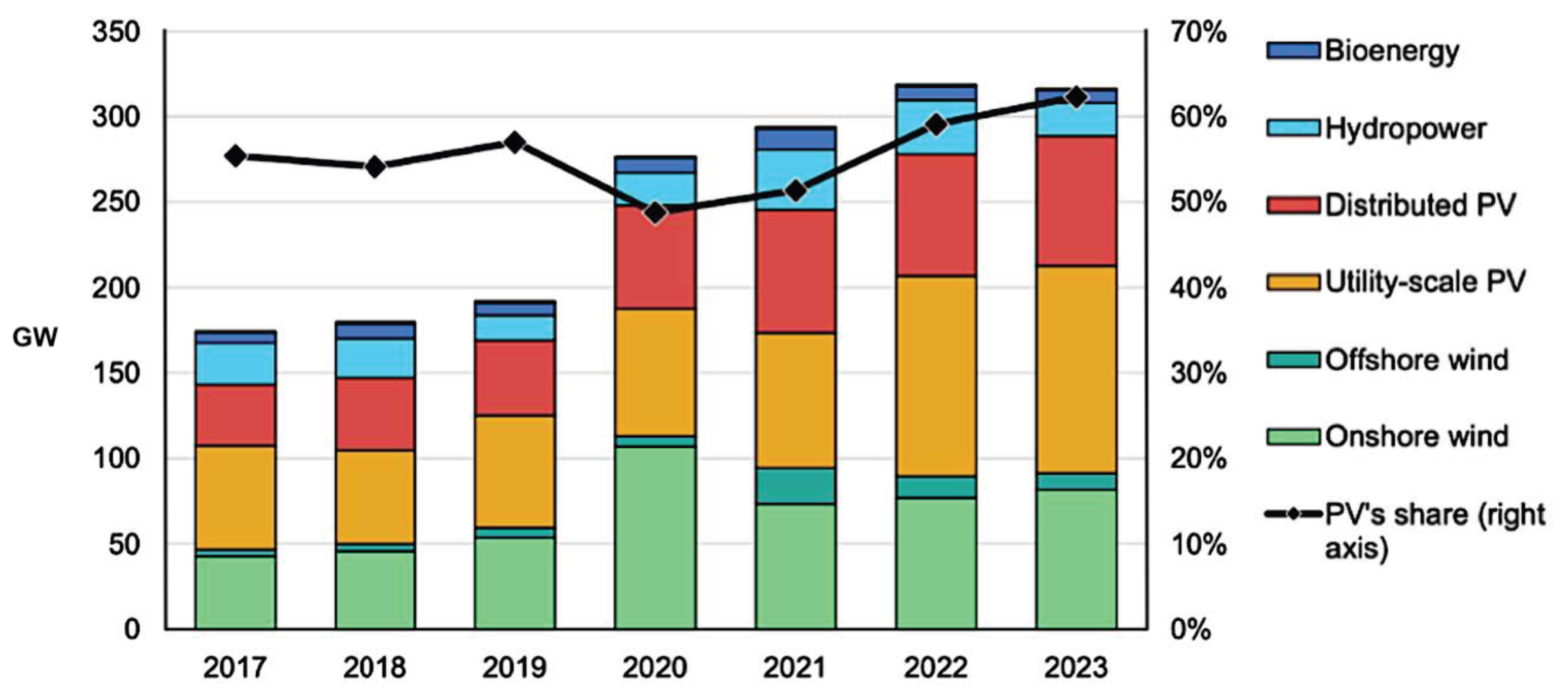
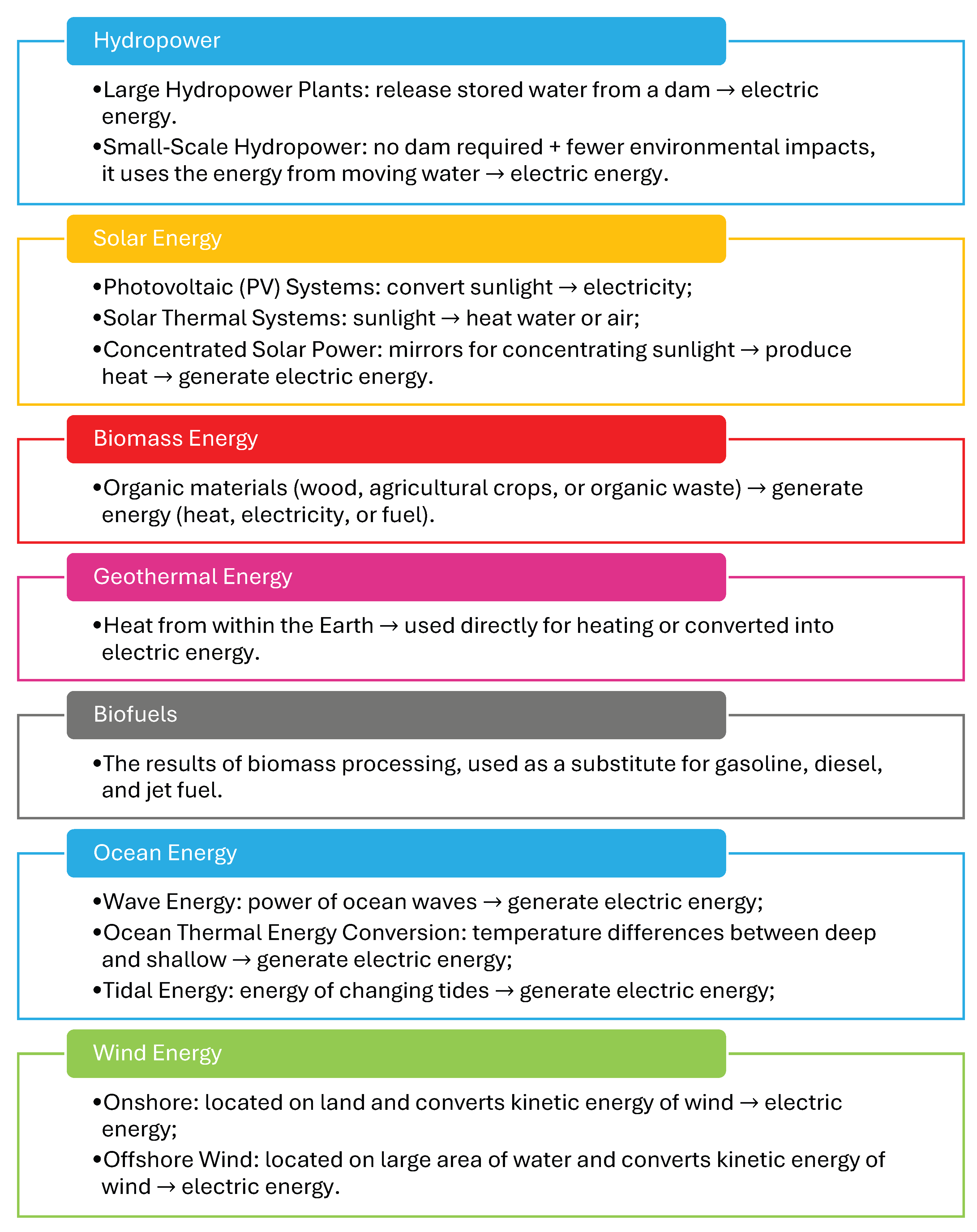
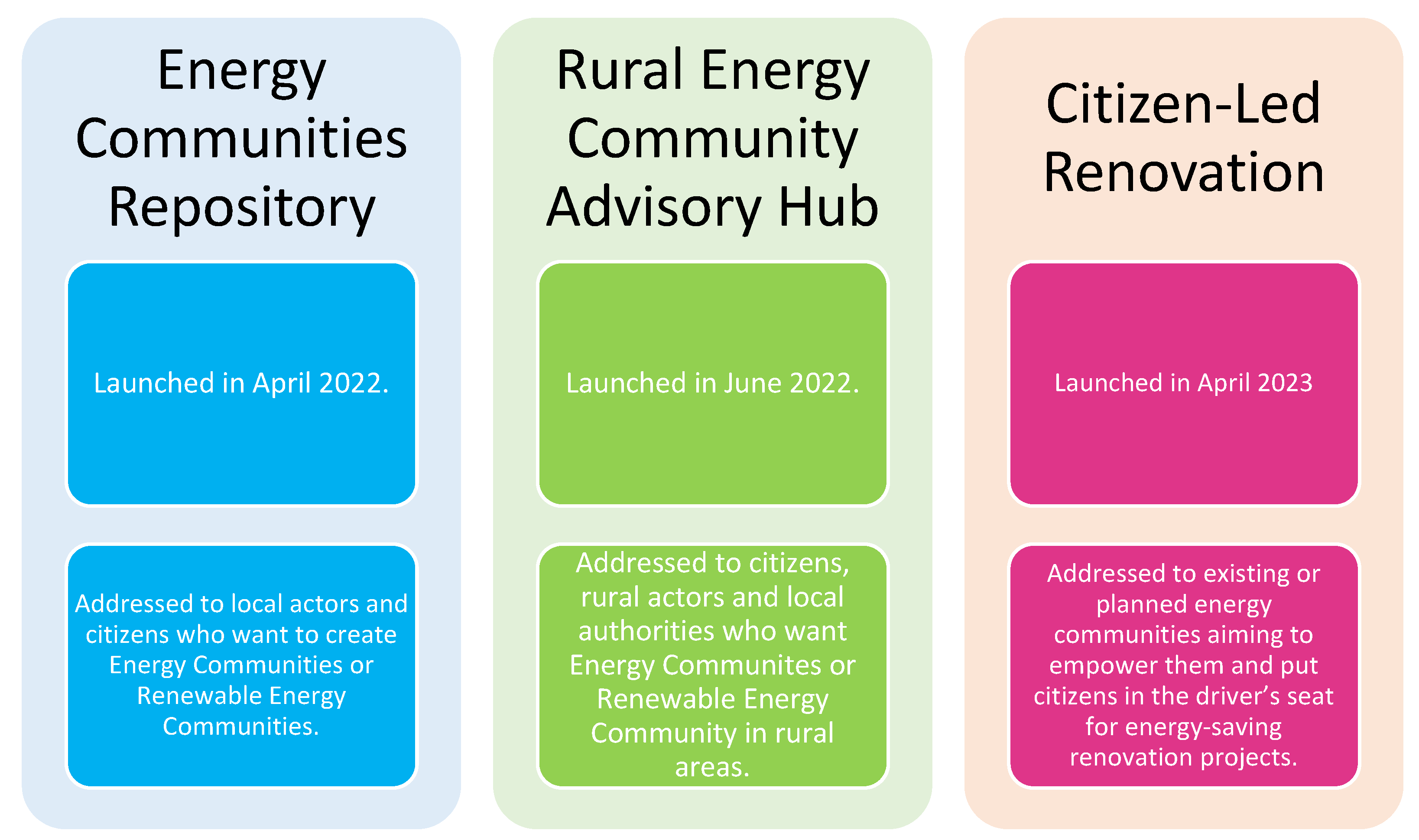
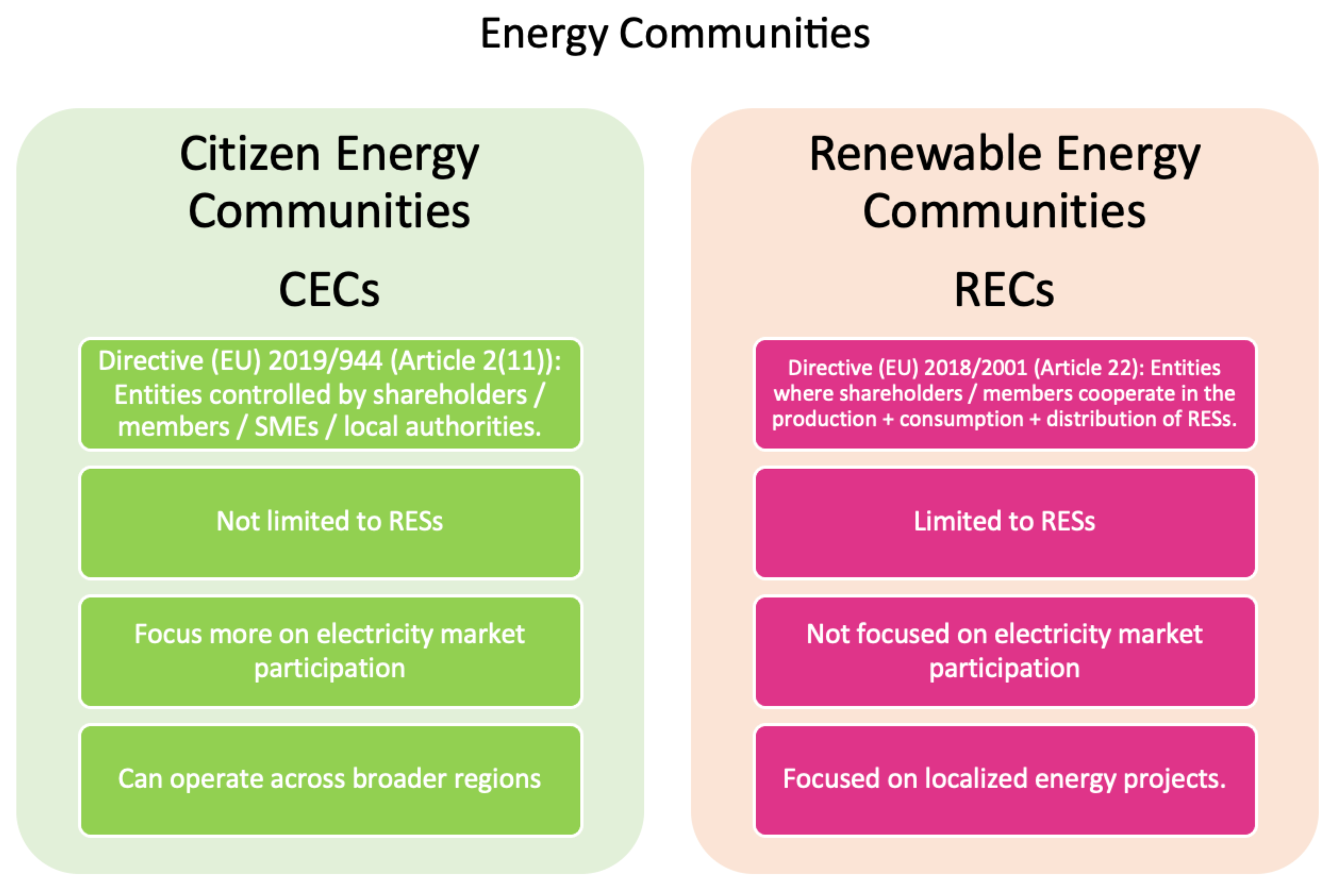
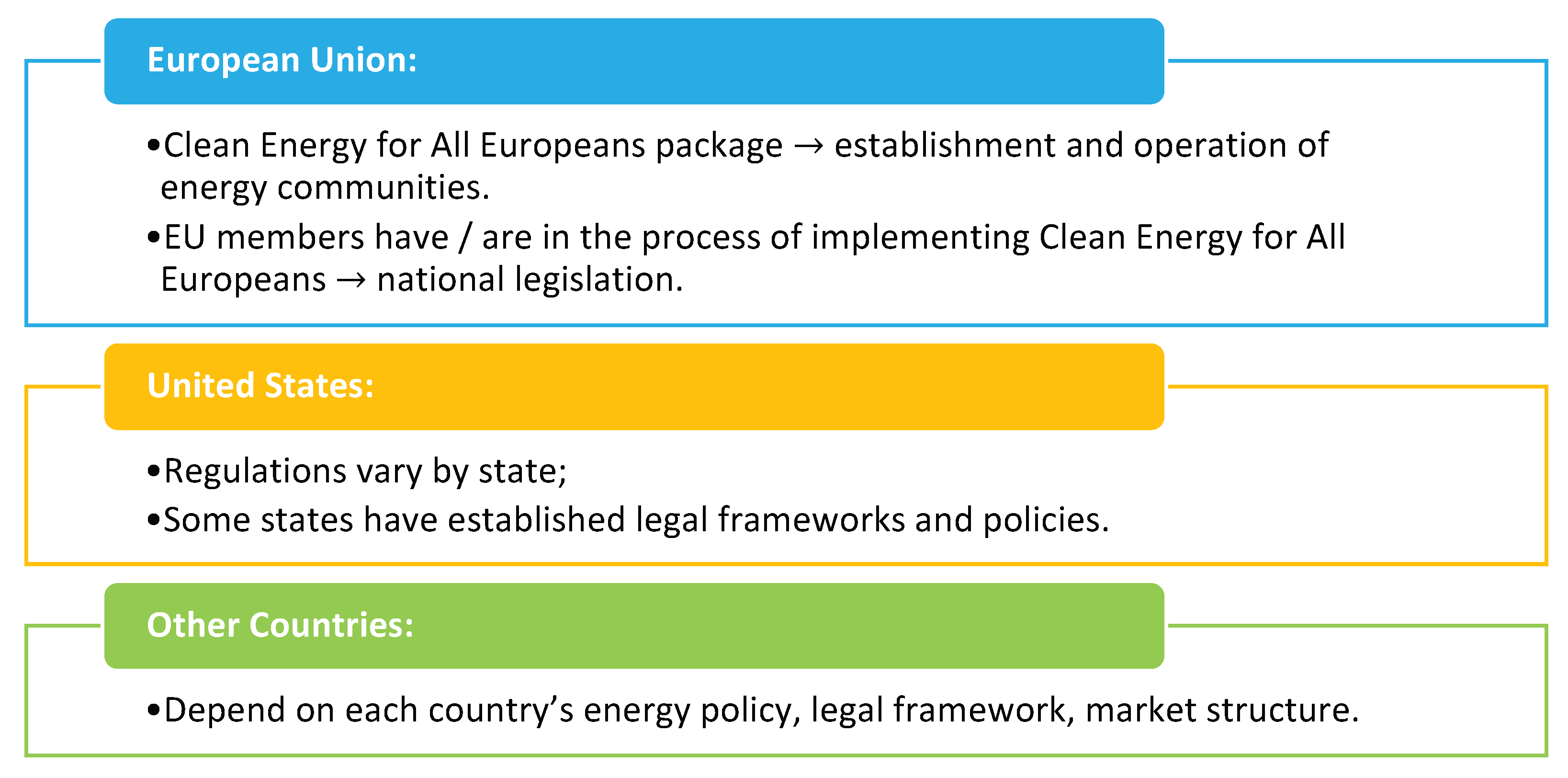


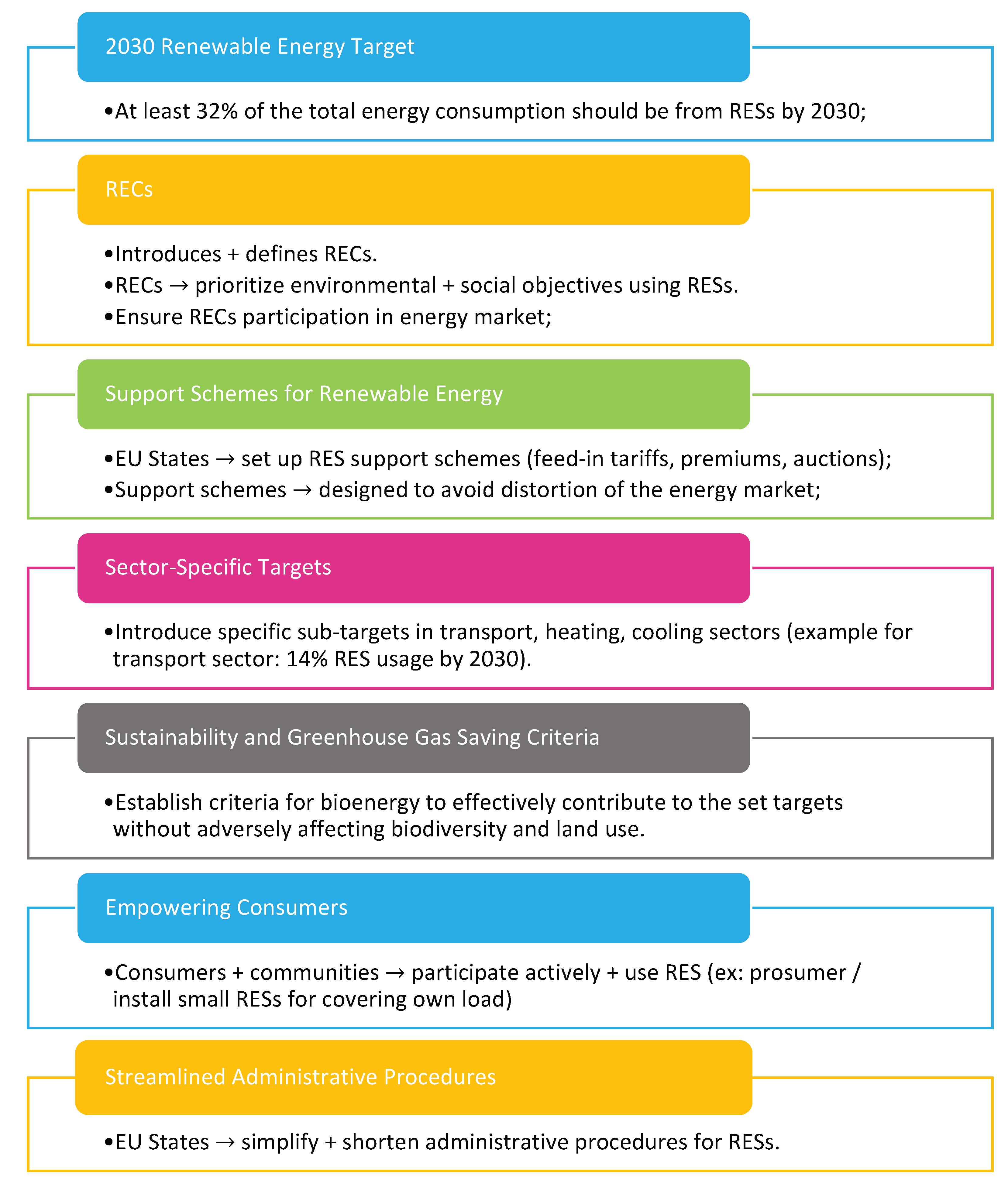
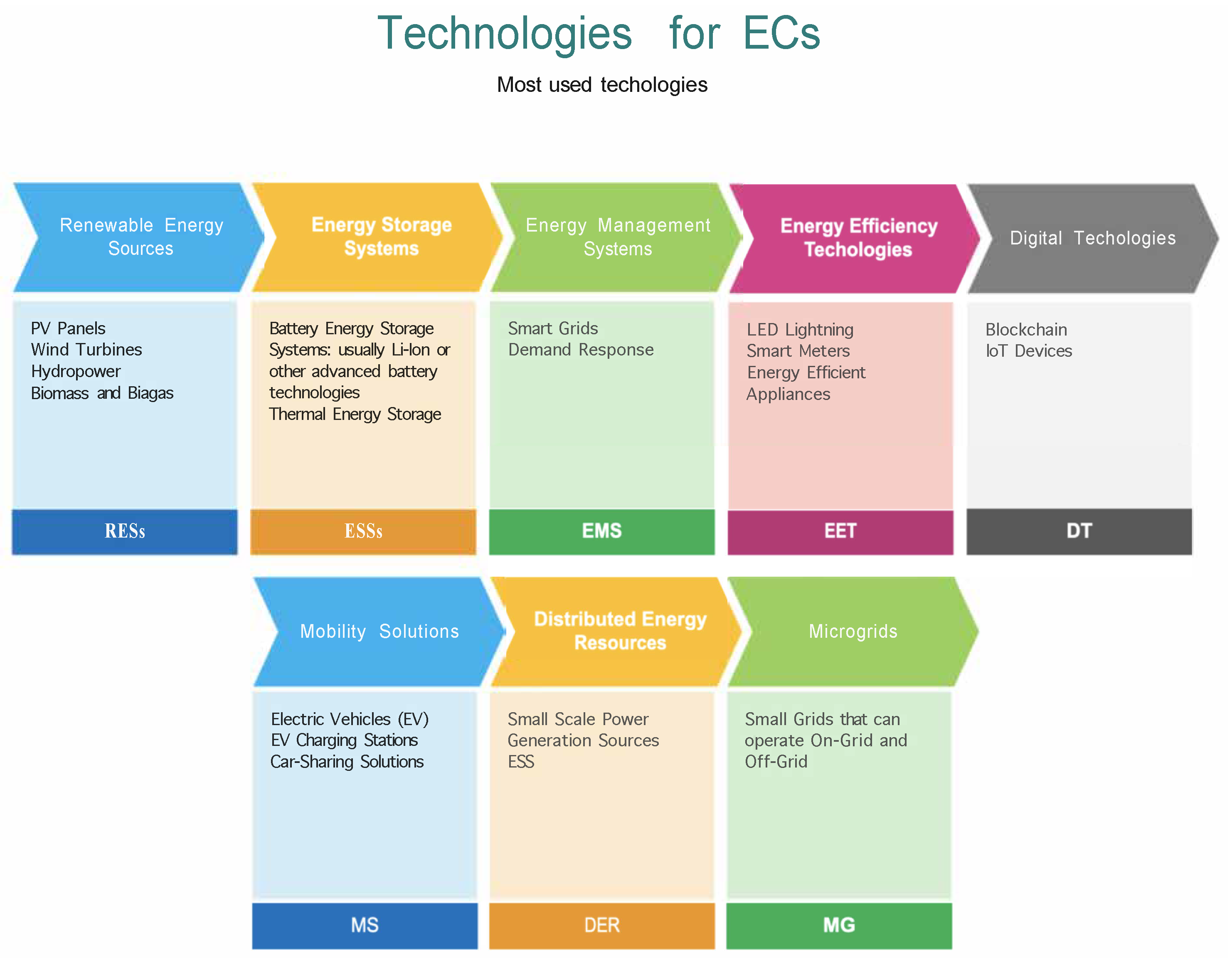

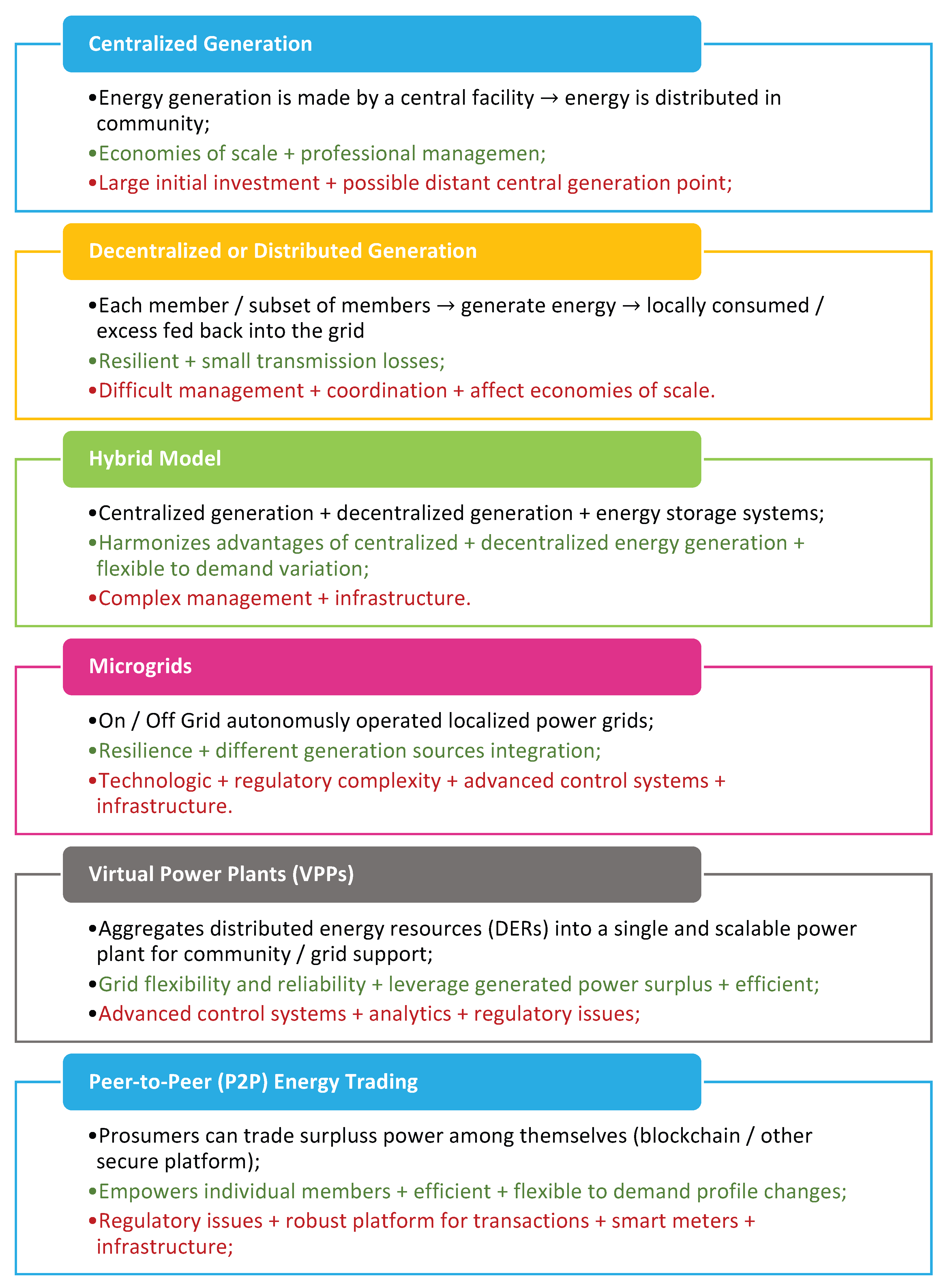
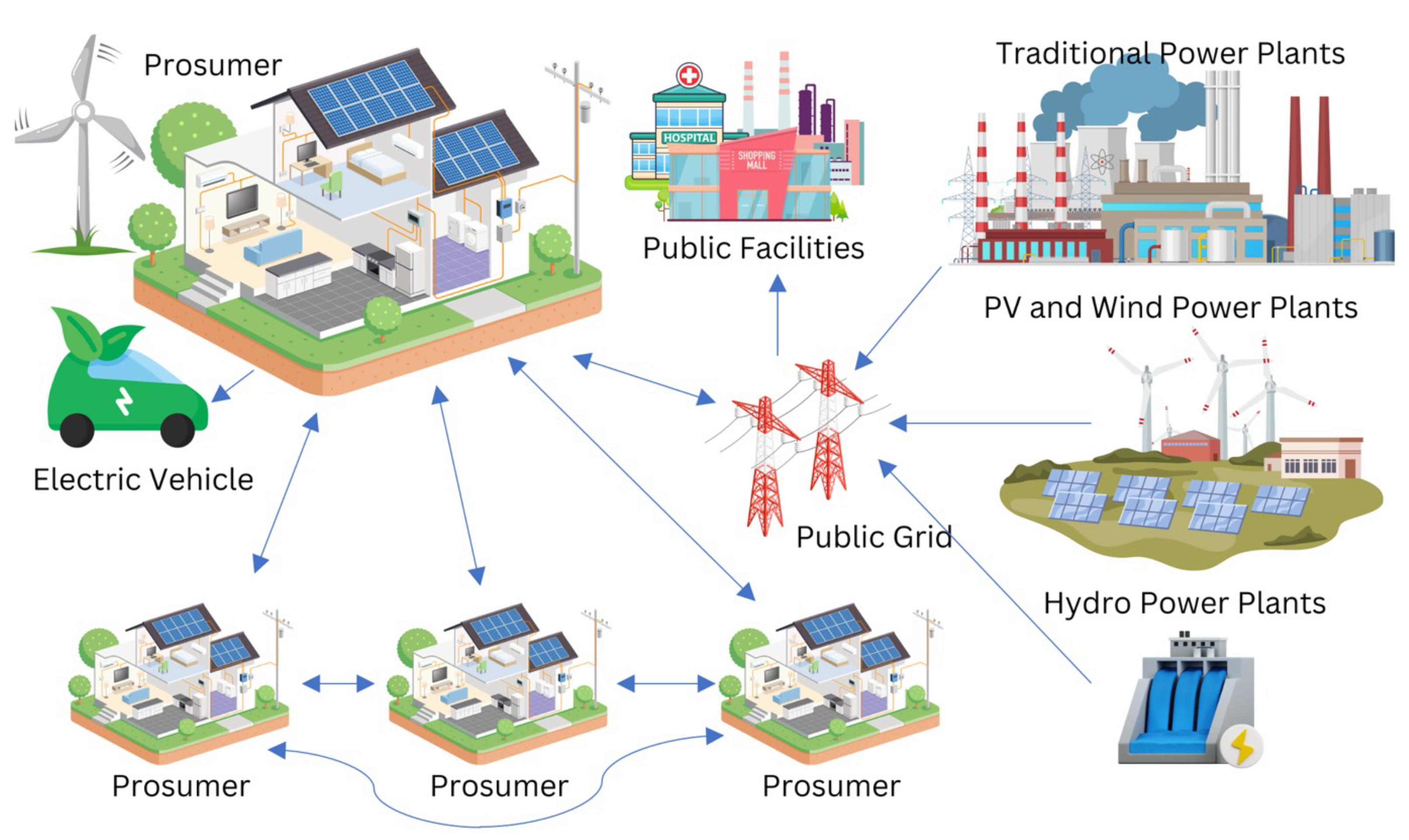
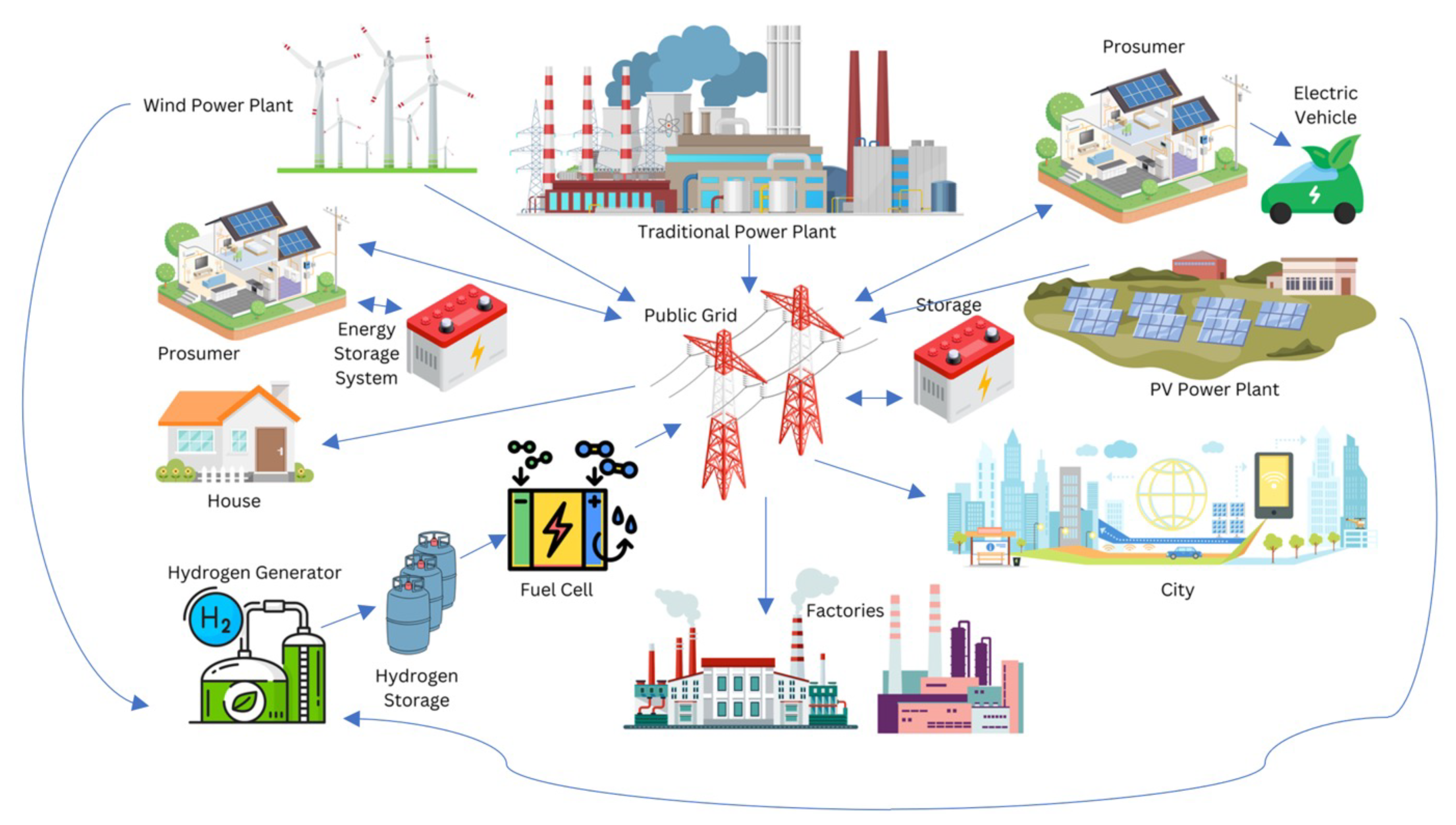

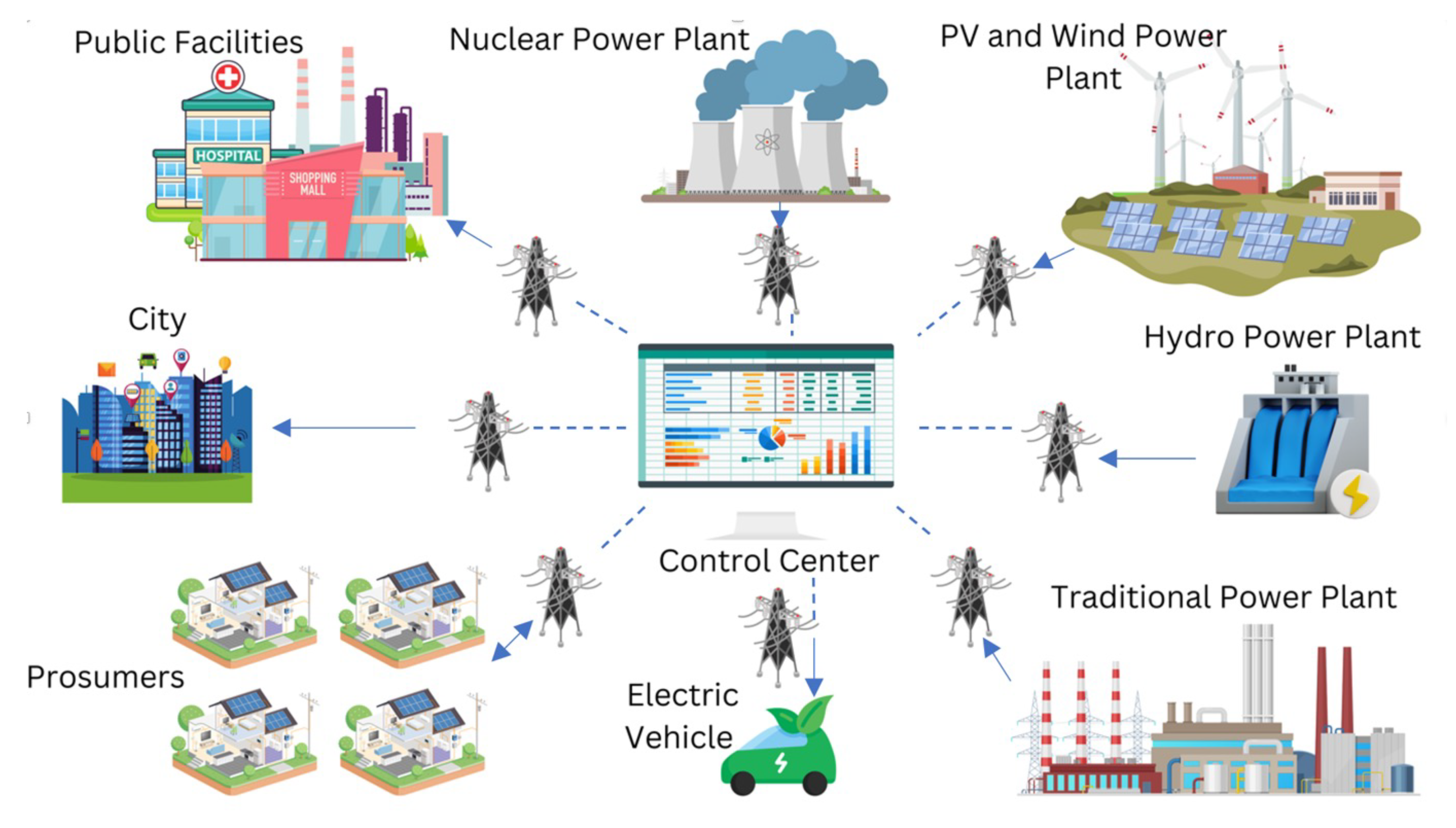
| Country | City | Community Characteristics | Grid Specifications | Key Outcomes | Ref. |
|---|---|---|---|---|---|
| Germany | Hessen | 82 properties, each with 5 kWp of PV. Each house must have the capability of storing energy. | Entega is a municipally owned utility offering electricity, gas, water, district heating, and energy services with about 570,000 energy customers; community energy storage with a gross capacity of 115 kWh and a charging capacity of 250 kW; residential units and community storage connected to the public grid. | Increase self-consumption to lower costs and increase independence; ecological and economic advantages in using PV and energy storage. | [90] |
| Germany | Cologne | 9 apartment buildings, 74 residential units; 225 kWp shared PV. | Community energy storage of gross capacity of 96 kWh and a charging capacity of 18 kW. Internal microgrid and community storage not connected to the public grid. | Economic savings; clean energy. | [90] |
| UK | Brighton | 7 MWp of solar rooftop; more than 700 members. | Local grid; electricity sold directly to the market. | Clean energy; economic advantages; solar energy to educational facilities. | [91,92,93] |
| UK | Nottingham | 1150 homes; 5 MW solar farm. | Low-voltage local grid. | Sustainable operation; counter fuel poverty increase in low-income areas; economic benefits; increased energy efficiency. | [91,92,93] |
| Netherlands | 484 communities are active at national level; these energy cooperatives involve 70,000 Dutch citizens. Solar capacity 74.5 MWp. | Local grid. | Energy efficiency; renewable energy supply; economic viability. | [94] | |
| Spain | Valencia | 100 kWp PV system. Battery energy storage, 100–300 kWh. Battery ownership: individual or communal. | Grid connected; local grid; surplus sold to the main grid. | Energy efficiency; economic profit; sustainable development. | [95,96,97] |
| Spain | Zaragoza | 50 dwellings; 255 Wp PV generation; 30 kW wind turbine. | Grid-connected system; economic optimization; optimal configuration of grid-connected polygeneration system. | Economic benefits; energy security benefits; advantages of thermal and electric integration. | [95,96,97] |
| Spain | Getafe | 95 kWp installed PV power; 100 houses. | Local grid; the energy deficit is taken from the upstream grid. | Energy-cost savings; social benefits; clean energy impact. | [95,96,97] |
| France | Les Ailes de Taillard | 164 communities. Wind farm ownership, 200 MW; >100 MWp photovoltaic generation. Biomass installed capacity 10 MW. Hydroelectric capacity 942 kW. Methanation installed 489 kW. | Local grid. | Social participation; citizen involvement; clean energy; energy efficiency; energy savings. | [98] |
| Philippines | Rural area electrification | >20 kW of photovoltaics, wind energy, and battery systems. | Local grid. | Techno-economic benefits; social benefits. | [99] |
| Norway | Oslo | >3000 residents; 17 MWp of PV power. | Local grid. | Zero-emission neighborhoods; social benefits; inclusive cooperation. | [100,101] |
| Norway | Trondheim | PV production from 15 different locations; 53 households. | Local grid. | Energy savings; economic benefits; renewable energy, clean energy. | [100,101] |
Disclaimer/Publisher’s Note: The statements, opinions and data contained in all publications are solely those of the individual author(s) and contributor(s) and not of MDPI and/or the editor(s). MDPI and/or the editor(s) disclaim responsibility for any injury to people or property resulting from any ideas, methods, instructions or products referred to in the content. |
© 2025 by the authors. Licensee MDPI, Basel, Switzerland. This article is an open access article distributed under the terms and conditions of the Creative Commons Attribution (CC BY) license (https://creativecommons.org/licenses/by/4.0/).
Share and Cite
Lazaroiu, A.C.; Roscia, M.; Lazaroiu, G.C.; Siano, P. Review of Energy Communities: Definitions, Regulations, Topologies, and Technologies. Smart Cities 2025, 8, 8. https://doi.org/10.3390/smartcities8010008
Lazaroiu AC, Roscia M, Lazaroiu GC, Siano P. Review of Energy Communities: Definitions, Regulations, Topologies, and Technologies. Smart Cities. 2025; 8(1):8. https://doi.org/10.3390/smartcities8010008
Chicago/Turabian StyleLazaroiu, Alexandra Catalina, Mariacristina Roscia, George Cristian Lazaroiu, and Pierluigi Siano. 2025. "Review of Energy Communities: Definitions, Regulations, Topologies, and Technologies" Smart Cities 8, no. 1: 8. https://doi.org/10.3390/smartcities8010008
APA StyleLazaroiu, A. C., Roscia, M., Lazaroiu, G. C., & Siano, P. (2025). Review of Energy Communities: Definitions, Regulations, Topologies, and Technologies. Smart Cities, 8(1), 8. https://doi.org/10.3390/smartcities8010008









